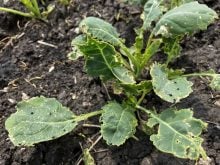During the last two decades, phosphorus runoff has been shown to be a main cause of water quality degradation. That has given rise to suggestions that regulations to direct farmers on where and how they can apply phosphorus may be coming.
Phosphorus runoff also has an immediate effect on a farmer’s fertilizer decisions.
Lake Erie in 2011 was a prime example of how serious the problem can be. Heavy winter and spring snowfall caused excessive runoff into surrounding streams and rivers. Heavy rainfall in April added to the volume of runoff water flowing into the lake from agricultural areas, bringing with it tonnes of phosphorus to nourish algae in the west end of the lake.
Read Also

Growing garlic by the thousands in Manitoba
Grower holds a planting party day every fall as a crowd gathers to help put 28,000 plants, and sometimes more, into theground
When algae die, bacteria break it down and the decaying process consumes oxygen from the water, creating dead zones where fish cannot survive. Algae can make people ill and cause death in pets.
One of the researchers involved in tracking phosphorus is University of Saskatchewan soil scientist Jeff Schoenau. He recently headed up a project comparing the difference in phosphorus runoff from snowmelt and rainfall. Data gathered by his team would be used to give farmers a better grasp on managing fertilizers, especially phosphorus.
In a recent interview Schoenau posed the question, “In what form is that phosphorus ending up in the soil and in the runoff. Is it calcium phosphate or is it aluminum phosphate?
“The important thing we did in the study was apply some rather sophisticated state-of-the-art spectroscopic techniques.”
Spectroscopy is the study of the interaction between matter and electromagnetic radiation. Spectroscopy originated through the study of visible light dispersed according to its wavelength by a prism. In its most modern form, spectroscopy is practised at the Canadian Light Source Synchrotron at the U of S. A synchrotron accelerates charged particles, such as electrons into a circular tunnel at almost the speed of light, like a hi-tech merry-go-round for atoms.
The CLS opened in 2004 after a campaign by the scientific community to establish a synchrotron radiation facility in Canada. It has more than 1,000 individual users, including researchers looking at viruses, superconductors, dinosaurs, industrial science and soils.
“We used some very powerful technology. We used the Canadian Light Source Synchrotron to analyze our samples. We used phosphorus 31 nuclear magnetic resonance to give us some insight into just what forms of phosphorus are in the soil and in the runoff water.”
It’s probably fair to say Jeff Schoenau has the dirt on Saskatoon’s big merry-go-round.
Contact ron.lyseng@producer.com

















